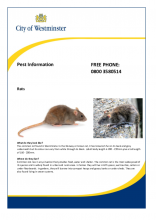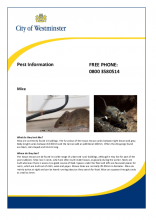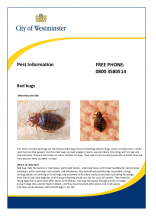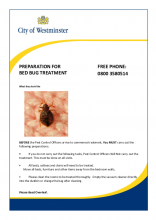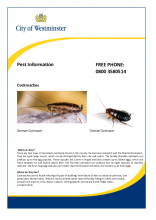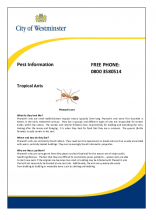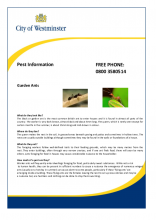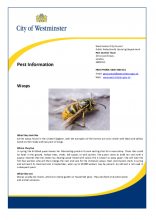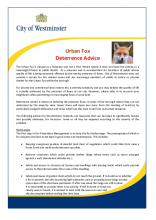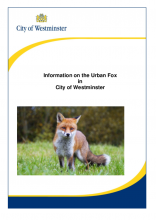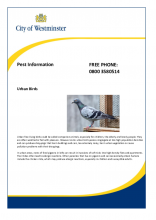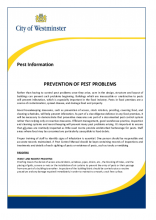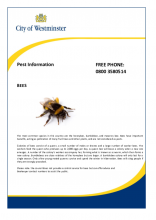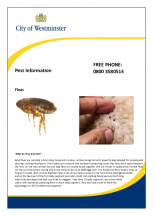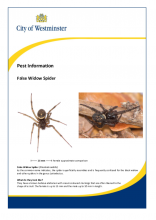Pest control
Learn about our pest control services for residents.
COVID-19
The council’s Pest Control service has continued to carry out the service uninterrupted to resident’s homes throughout the entire pandemic. However, if you are about to book an appointment or have an existing visit and you have:
- tested positive for COVID-19
- been told to isolate
- believe you may have symptoms
Please call the council on 0800 358 0514 and ask to postpone your appointment until your period of isolation is over or you are recovered.
If you do not manage to contact the council before the pest control officer arrives, please inform the officer before they step into your home to avoid contact. You will then be able to re-arrange the appointment for another time. When our officers attend your property please wear a mask and maintain 2 metre social distancing. This is to protect you and the officer. If this is not complied with the officer will terminate the visit. We do this to try to prevent any unintended spread of the virus should either you or the officer be asymptomatic. We thank you for your understanding.
About the service
Our pest control officers are employees of the council and have all qualified diplomas in Royal Society for Public Health (RSPH) in pest control as well as continuous annual training. All staff have many decades of service experience in pest control nearly all of which, in Westminster Housing stock. We are committed to providing our customers with an effective, safe and value-for-money service.
The team provides control of pests via service agreements to the Housing Department for Council Tenants and Leaseholders, council municipal buildings (such as Libraries and offices) and Parks and Gardens department. Commercial work for existing customers from private business and homes are managed by our Trading team. Please note, the team is not taking on any further work at this time (we will update this site should this status change in the future. For NHS referred customers, we provide a service for the collection of sharps and for dialysis patients, clinic waste collection and disposal.
How to make an appointment
To book an appointment at a time and date convenient to you, please get in touch:
Phone: call us on 0800 358 0514 (or if you're calling from abroad please use +44 207 641 1522).
Email: [email protected]
Appointments are taken in customer preferred time slots through each working day from Monday to Friday:
- 8.30am to 10am
- 10am to 12pm
- 1pm to 3pm
If our officer is delayed at a previous job they will call you to let you know when they expect to arrive or give you the opportunity to re-book the appointment. Our staff have a printed appointment schedule with your contact details and the previous visit details of each new case. The officer will also call you prior to arrival to let you know when they expect to arrive.
Charges for tenants in a City of Westminster Housing property for pest control service is covered under your tenancy agreement and Leaseholders are recharged through their annual service charge, with the Housing Department.
Council pest control officers
All our staff have ‘City of Westminster’ identification badges and will identify themselves to you. Our staff will behave in a considerate manner and show respect for yourself and your residence. We operate a ‘No Smoking’ policy and follow ‘Best Practice’ in the high standard of our service delivery.
What happens next?
At the start of the visit
Our officer will identify themselves and explain to you the purpose of the visit is and how it will be done. Please ask the officer if you are unsure or would like to know more.
Survey
Normally the first time we come to see you the officer will carry out a survey of your residence. This is an information gathering process to enable the officer to formulate the next step. The survey typically consists of a visual inspection of the site, queries to you and any information you may give. After which the next step will be explained to you.
Treatment
The officer will explain the procedure for the application of the treatment and answer any queries you may have. Typically, these may consist of the laying of bait stations, applications of sprays, powder, gel or Ultra Low Volume (mist or ‘fogging’ pesticides). In addition there may be inspections of drains and minor proofing works. Intensive proofing works can also be arranged. The officer will make additional reports for this purpose and give you advice on what you can do to self help.
After the visit
After the completion of the visit the officer will inform you of the next step. If the treatment requires further visits an appointment will be made with you before the officer leaves site. If the case has concluded, the officer will inform you of this, remove bait stations and give you advice on what you can do to help prevent infestations.
What if I need help preparing my home for a treatment?
Some treatments such as bed bug control require site preparation in which case we will have posted to you a guide on how to prepare your home for the treatment. If you are unable to do this just call us and let us know your address and when we are due to visit and we will send additional staff to help with the preparation.
What if I hear scratching noises?
Noises are not necessarily rodents but, we want to hear from you if you think you have pests. Call us and we will carry out an inspection.
What if after a treatment I find dead rodents?
Call us and we will be out same day to remove them from your home.
What if after a rodent treatment there is a foul smell my home?
This can happen when (though rarely) rodents have died under floor boards etc. Most rodents take one to two weeks to decay and stop smelling. Call us and we will attempt to remove the bodies during the visit if they are accessible or make arrangements for floorboards to be lifted as appropriate. We can also use a masking spray in the interim period.
Health and safety
If treatments are to be carried out you will be issued with a ‘Notice to Occupier’ form detailing important and Health and Safety information. You are required to sign for these forms. All pesticides used by us have been passed by DEFRA. It is the policy of this unit to use the safest and least toxic chemicals that have the minimal impact on the environment. Whilst providing the most effective and efficient treatment of infestations. You may remain present during the application of ‘gels’ and bait stations. However, In the case of spray applications it is preferable that you vacate the premises for approximately 20 minutes. Or, In the case of Ultra Low Volume (ULV) applications you must vacate the premises for approximately 2 to 4 hours.
All efforts are made to place pesticides in the safest locations, the type of pest and layout of dwellings often dictate the actual positions of pesticides. It is your responsibility to ensure children and pets are kept well away from pesticides. (Fish tanks are to be covered during treatment).
Potential side effects
With the use of the most modern pesticides impact and inconvenience are kept to a minimal level. Every effort is made to avoid damage (such as stains) in the process of treatment application. However, this service does not accept liability should any occur. Should you believe serious damage has occurred as a direct action of the pest control officer, you should write a full account to the pest control operations manager at the above address.
Sightings of rats on the street
We will carryout inspections of the immediate area to try and ascertain the origin and will make recommendations of findings appropriate agencies. Typically, Highways Department (for streets and gulley defects and Environmental Health teams for commercial and private dwellings). Please note we cannot carry out baiting on public highways. Should you be unfortunate to find a dead rat, fox or carcase of any kind on the public highway please report this to the Cleansing Department, who will remove it for safe disposal.
Information on the pests we treat
We treat the following public health pests. In addition, garden ants and squirrels are included as deemed a perennial nuisance:
- rats
- mice
- bed bugs
- cockroaches
- tropical ants
- garden ants
- wasps
Rats
What do they look like?
The common rat found in Westminster is the Norway or brown rat. It has brownish fur on its back and grey underneath but its colour can vary from white through to black. Adult body length is 200 to 270mm plus a tail length of 150 to 200mm.
Where do they live?
Common rats live in any situation that provides food, water and shelter. The common rat is the most widespread of its species and is widely found in urban and rural areas. In homes they will live in loft spaces, wall cavities, cellars or under floorboards. In gardens, they will burrow into compost heaps and grassy banks or under sheds. They are also found living in sewer systems.
Mice
What do they look like?
Mice are commonly found in buildings. The fur colour of the house mouse varies between light brown and grey. Body length varies between 60 to 90mm and the tail can add an additional 100mm. Often the droppings found are black, rod-shaped and 3 to 6mm long.
Where do they live?
The house mouse can be found in a wide range of urban and rural buildings, although it may live for part of the year outdoors. Mice live in nests, which are often built inside houses, especially during the winter. Nests are built wherever there is access to a good source of food. Spaces under the floor and lofts are favoured places for nests, which are built out of cloth, wool and paper. Mouse holes are normally 20 to 30mm in diameter. Mice are mainly active at night and can be heard running about as they search for food. Mice can squeeze through cracks as small as 5mm.
Bed bugs
What do they look like?
There are two main types of bed bug. The most common bed bugs are the Common bed bug, found in dwellings, and the Martin bug, which normally lives in birds' nests but can bite people. Common bed bugs are oval wingless insects, approximately 5mm long, with six legs and two antennae. They are red-brown in colour and flat in shape. Their colour turns to red/purple after a blood meal and they become more rounded in shape.
Where do they live?
Bed bugs hide themselves in mattresses, within bed frames, under bed bases, within bed headboards, behind loose wallpaper, within paintings, wall sockets, and telephones. Also behind wall partitioning, suspended ceilings, skirting boards, on clothing or furnishings, and anywhere with a dark crack/crevice/seam providing harbourage. They like to stay close together. With frequent feeding, adults can live for up to 18 months. They breed by laying eggs that usually hatch after about 10 to 20 days. The bugs then grow through a series of stages. At each stage they need to feed on blood, until they become adults after about nine to 18 weeks. A female can lay between 150 and 345 eggs in her life.
The presence of bed bugs in a room can be detected by the following:
- blood spotting on bedding
- brown excrement spots close to where they live and on bedding
- whitish/opaque un-hatched and hatched eggs
- in heavy infestations, a sweet almond smell is common
- bed bugs are not normally seen during the day
Bed bug treatment pre-visit preparation
Before the pest control officers arrive to commence treatment, You must carry out the following preparations:
- all beds, settees and chairs will need to be treated.
- move all beds, furniture and other items away from the bedroom walls,
- please clean the rooms to be treated thoroughly. Empty the vacuum cleaner directly into the dustbin or change the bag after cleaning.
- Please clear all rooms of any clutter so furniture can be moved.
- Remove all stored items from under the bed, and place on the floor in the centre of the room.
If you do not carry out the following tasks, pest control officers will not carry out the treatment. This must be done on all visits.
Cockroaches
What are they?
There are two types of cockroach commonly found in this country the German cockroach and the Oriental cockroach. They are quite large insects, which can be distinguished by their size and colour. The female Oriental cockroach can produce up to five egg capsules. These capsules are 12mm in length and each contain up to sixteen eggs, which will hatch between six and twelve weeks later. The German cockroach can produce four to eight capsules at monthly intervals. The 6mm long egg capsules are smaller than the Oriental cockroach, but contain up to thirty eggs.
Where do they live?
Cockroaches can be found infesting all types of buildings from blocks of flats to industrial premises, and particularly kitchen areas. They are nocturnal and spend most of the day hiding in cracks and crevices around such areas as sinks, drains, cookers, skirting boards, service ducts and fridge motor compartments.
Tropical Ants
What do they look like?
Pharaoh's ants are small reddish/brown tropical insects typically 2mm long. Pharaoh's ants were first recorded in Britain in the early nineteenth century. They live in groups and different types of ants are responsible for certain duties within the colony. The worker ants (sterile females) have responsibility for building and extending the nest, looking after the larvae and foraging. It is when they look for food that they are a nuisance. The queens (fertile females) usually remain in the nest.
Where and how do they live?
Pharaoh's ants are commonly found indoors. They need warm temperatures to breed and are thus usually associated with warm, centrally heated buildings. They are increasingly found in domestic properties.
Garden Ants
What do they look like?
The black or garden ant is the most common British ant to enter houses and it is found in almost all parts of the country. The worker is very dark brown, almost black and about 5mm long. The queen, which is rarely seen except for certain months in the summer, is about 15mm long and mid-brown in colour.
Where do they live?
The queen makes the nest in the soil, in grassed areas beneath paving and patios and sometimes in hollow trees. The nests are usually outside buildings although sometimes they may be found in the walls or foundations of a house.
Wasps
What do they look like?
All the wasps found in the United Kingdom, with the exception of the hornet, are very similar with black and yellow bands on their body and two pairs of wings.
Where do they live?
In spring, the fertilized queen leaves her hibernating quarters to seek nesting sites for a new colony. These sites could be holes in the ground, hollow trees, sheds, loft spaces or wall cavities. The queen starts to build her nest with a papery material that she makes by chewing wood mixed with saliva; this is known as wasp paper. She will raise the first few workers who will then enlarge the nest and care for the immature wasps. Nest construction starts in spring and will reach its maximum size in September, when up to 10,000 workers may be present. An old nest is not used in subsequent years.
Recommendations we provide
We provide recommendations on:
- foxes
- squirrels
- pigeons
- proofing (following a housing repairs)
Foxes
We do not provide a service for the capture, destruction or prevention of foxes. We do however, provide useful information relating to the prevention and causation for members of the public to use.
Squirrels
If you have Squirrels on Housing Department estates/premises. Please report the issue to your estate office or building manager. A work request will then be raised to our team to inspection and either deal with the matter or best advise on the appropriate solution.
Pigeons
If you have bird issues on Housing Department estates/premises. Please report the issue to your estate office or building manager. A work request will then be raised to our team to inspection and either deal with the matter or best advise on the appropriate solution.
Proofing advice
We provide proofing advice which provides a general proforma based on our experience of proofing issues within existing dwellings. We can also provide proofing advice where rodent infestations often reoccur due to gaps left from installing appliances, typically in kitchens and bathrooms, or the fabric of the buildings allow for rodent infestation.
These are not automatically done for every dwelling and are based upon the officer's inspection. The officers can advise on what they think would be beneficial and to help prevent future infestations.
These are emailed direct to the Housing Departments Repairs team; where they assign a job to their contractor to carry out the work. For queries on job progress please refer to your estate office staff for updates on your proofing job. Please note once we have sent the proofing advice we have no further information on its progress.
In cases where our advice is not deemed sufficient and a more in depth approach is required, we advise the Housing Department to obtain a detailed proofing report. This can come from a qualified person, such as a building surveyor or an environmental health officer.
Flies
We do not deal with flies, please visit the British Pest Association for recommendations on how to treat flies. Visit The British Pest Control Association (BPCA) The British Pest Control Association (BPCA) for more information.
Additional pest information
Bees
The most common species in this country are the honeybee, bumblebee, and masonry bee. Bees have important benefits, acting as pollinators of many fruit trees and other plants, and are not considered as pests. Colonies of bees consist of a queen, a small number of males or drones and a large number of worker bees. The workers feed the queen who produces up to 2,000 eggs per day. A queen bee will leave a colony when a new one emerges. A number of the colony’s workers accompany her, forming what is known as a swarm, which then forms a new colony. Bumblebees are close relatives of the honeybee but are larger. A bumblebee colony will only last for a single season. Only a few young mated queens survive and spend the winter in hibernation. Bees will sting people if they are strongly provoked.
Please note: the council does not provide a control service for bees. Advice can be gained from the British Pest Control Association (BPCA) for advice, information, quotations and work by accredited pest control companies.
Contact details:
- email: [email protected]
- web: bpca.org.uk
- live chat: bpca.org.uk/chat
More information for bees can also be found from the British Beekeepers Association (BBA).
Fleas
What do they look like?
Adult fleas are normally 1 to 4mm long, brownish in colour, without wings but with powerful legs adapted for jumping and piercing, sucking mouthparts. Their bodies are covered with backward projecting spines that help them move between the hairs on the host animal. Cat and dog fleas are usually found together and are similar in appearance. Female fleas can live up to two years, during which time they can lay up to 1,000 eggs each. The female cat flea’s head is twice as long as it is wide. Both cat and dog fleas have a row of very heavy spines on the front of the head (genal comb) and on the back part of the first body segment (pronotal comb). Cat and dog flea larvae are ¼ inch long when fully developed and look much like fly maggots. They have thirteen body segments, are a dirty-white colour with backward projecting hairs on each body segment. They also have a pair of hook-like appendages on the last abdominal segment.
Where do they live?
Adult fleas live exclusively as parasites of warm-blooded animals. The females lay their eggs close to or on the infested animal. Wall-to-wall carpeting and soft furnishings also provide a relatively undisturbed environment for fleas to develop. They can also live in cracks and crevices in bare floors.
False widow spider
What do they look like?
They have a brown bulbous abdomen with cream coloured markings that are often likened to the shape of a skull. The female is up to 15 mm and the male up to 10 mm in length.
Where and how do they live?
They mainly set up home in buildings and in fences. For years this spider was contained within a small area around Devon but has now spread all along the southern counties and is now found in Lincolnshire and the mid lands. Its 'scaffold web' differs from others of the genus in the exceptional strength of the silk, and in the tubular retreat that is partly concealed in a deep crack or hole. They have poor eyesight and depend mostly on vibrations via their webs to orient themselves to prey or warn of threats.
Rats and mice, what's the difference?
Young rats are often mistaken for mice and visa versa. Most of the differences between the two shown above still apply as well as, young, weaned rats are still larger than adult mice, weighing around 100 grams (3.5 ounces) at six weeks.
Here's what to look for:
- baby rats will have more juvenile proportions than adult mice. Their heads and feet will be large relative to their bodies, their faces will be stubby and blunt with wide noses
- adult mice, on the other hand, will have adult proportions: a small, triangular head with a small nose and little delicate feet as compared to the body
Other than a brief sighting most people’s realization that they have a rodent problem comes when they start finding droppings. These will often be used as the main way of telling rats and mice apart.
You will be asked about their size (see above), but the easiest way is to equate them to everyday objects (mouse droppings are very much like grains of rice in size and shape, but will generally be black). They can be found in quite large numbers and generally scattered. A mouse with access to adequate food can defecate every 10 minutes. Rat’s droppings can be scattered, but usually found in groups.
Customer complaints
The people who can best deal with a complaint are those who provide the service. So you should contact your local office or service manager about your complaint.
We can usually sort out mistakes and misunderstandings quickly and informally at this stage. If you're not sure who to contact, you can call 0800 3580514. We aim to respond, at this stage, within 10 working days.
Commercial and private residents
We advise commercial and private residents to contact the British Pest Control Association (BPCA) for advice, information, quotations and work by accredited pest control companies.
Contact details:
- email: [email protected]
- web: bpca.org.uk
- live chat: bpca.org.uk/chat
Published: 21 December 2020
Last updated: 13 September 2023

